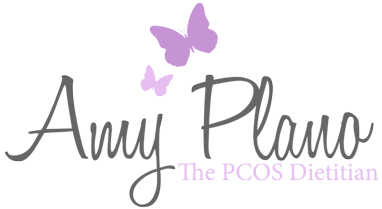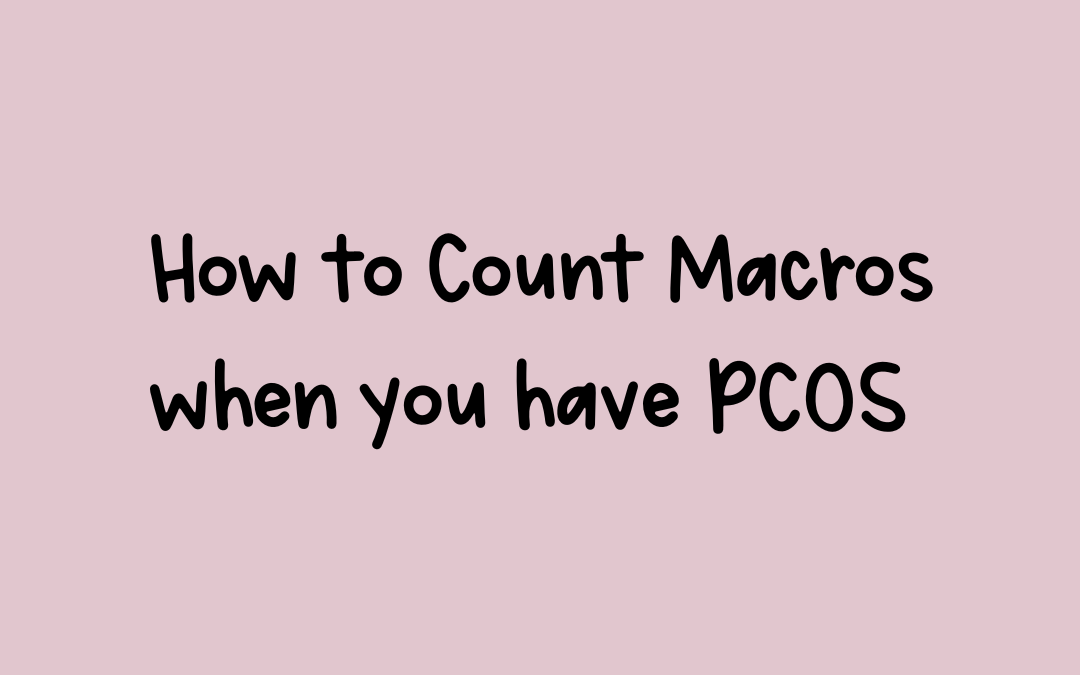
by AmyPlano | Jul 23, 2019 | PCOS and carbohydrates, PCOS and Fats, Uncategorized, Weight Loss
How to Count your Macros when you have PCOS
Learning how to count your macros when you have PCOS is a hot topic! But, before I walk you through how to do this – I need to explain what the heck macros are in the first place. Macros or more properly known as macronutrients represent the amount of the three nutrients: carbohydrates, protein and fat you need to consume to reach to achieve your dietary goals. These values are expressed in grams and are all based on the amount of calories you consume daily.
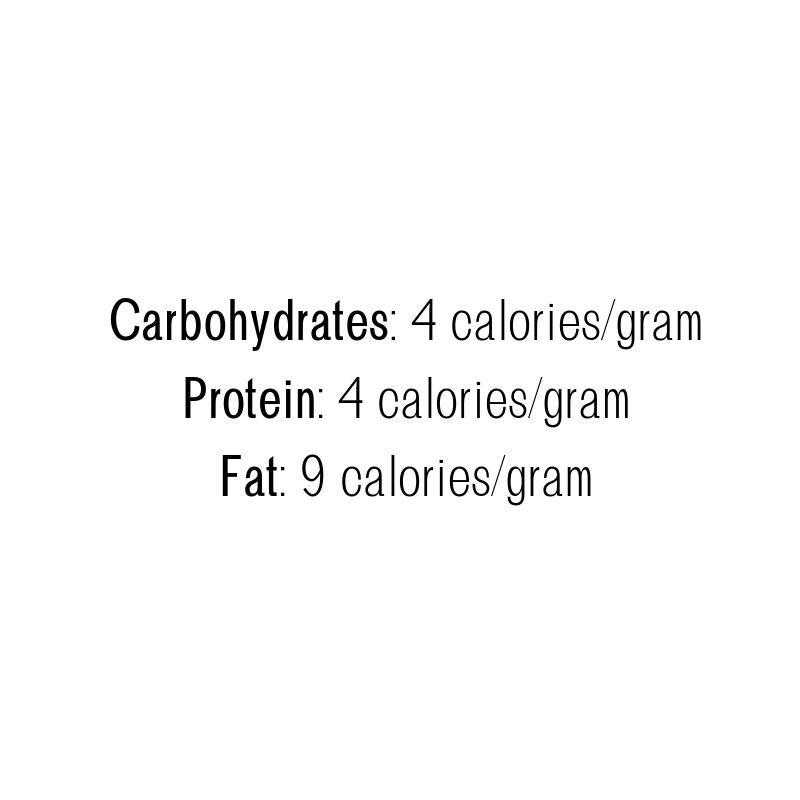
In order to determine our macros when you have PCOS, you need to know how many calories you should be consuming. In addition, you need to know the percentage of each macronutrient you should be consuming daily. The PCOS Dietitian suggests the following breakdown:

So, basically when someone tells you they are, “Counting their macros,” this simply means they are counting and tracking the amount of carbohydrates, protein and fat they take in each day.
Calories
Before we determine how to count your macros when you have PCOS we need to talk a bit about calories. While everyone with PCOS has different dietary goals, most women are seeking weight loss. Therefore, for the premise of this blog, we are going to base the calories and macros on the short-term goal of weight loss.
However, as you can imagine determining your calories for weight loss when you have PCOS is not a simple process. Your calorie needs are just as unique as you are! Your calories for weight loss depend on many variables including your: age, gender, height, weight, body fat, physical activity level, type of job and even your sleep patterns. Therefore, I would highly recommend meeting with a Registered Dietitian who specializes in PCOS to either have your metabolism tested or just to obtain some guidance on how to determine your personalized calorie needs.
In order to illustrate how to count your macros when you have PCOS, we are going to use a calorie amount of 1,400 calories per day. This would likely be a good starting point for a 25 year old female who is 5 feet 4 inches, weighs 180 pounds, is around 30 percent body fat, works out 3 times per week doing cardio 30 minutes per session, has a sedentary desk job and gets around 5 to 6 hours per night of uninterrupted sleep. Once again, your needs will likely be different, but I am using 1400 calories to provide a concrete example of how to determine your macros.
Carbohydrates and PCOS
Not surprisingly, the majority of food we eat is typically made up of carbohydrates? Carbohydrates provide energy for the body. The two main types of carbohydrates – are simple carbs (SC) and complex carbs (CC). SC occur naturally in the foods we eat. They are foods like yogurt and milk products, fruit and honey. SC are also added to food when it is processed. Examples of foods with added SC include soft drinks, cookies, ice cream, most granola bars and candy. Conversely, CC are considered more nutrient dense as they contain more fiber, vitamins and mineral than SC. Complex carbohydrates include foods made from whole grains like rice and pasta as well as legumes (beans, lentils and peas) and starchy vegetables like corn and winter squash.
In our bodies SC break down very quickly. They enter the bloodstream almost immediately causing a spike in blood sugar. This in turn prompts a rapid increase in insulin. Consequently, eating too many SC can exacerbate the symptoms of PCOS by worsening IR and facilitating weight gain.
Conversely, complex carbohydrates can improve insulin resistance as they slowly release glucose allowing for optimal insulin regulation. Due to their slow absorption rate, CC promotes an increased sense of fullness and satiety. That is why I encourage the majority of your be complex carbohydrates.
How to Determine your Carbohydrates Macros when you have PCOS
When you have PCOS, I generally recommend keeping carbohydrates under 40 percent of your total calories. This would mean if you were following a 1,400 calorie diet, you would should be consuming 140 grams of carbohydrates or less per day.
How did I get to that number? Let’s take a look at my math.

Protein and PCOS
Protein is essential. It is pretty much required for every single structure and action in the body. Everything from your hair, nails, skins and bones to your ligaments, hormones and enzymes are composed of protein.
Protein is derived from animal foods like meat, poultry, pork, fish, seafood, eggs and dairy. Plant based proteins include legumes, nuts and soy.
Protein takes longer than carbohydrates to digest and confers a sense of satiety. Also, generally protein by itself doesn’t require much insulin to be processed. This is because protein is not converted to glucose. Hence, protein does not raise insulin like carbohydrates. That is why I often recommend including a small amount of protein with your meals and snacks. This helps stabilize blood sugar and improves your overall insulin response.
How to Determine your Protein Macros when you have PCOS
When you have PCOS, I generally recommend keeping carbohydrates at around 30 percent of your total calories. This would mean if you were following a 1,400 calorie diet, you would should be consuming around 105 grams of protein per day.
How did I get to that number? Let’s take a look at my math.
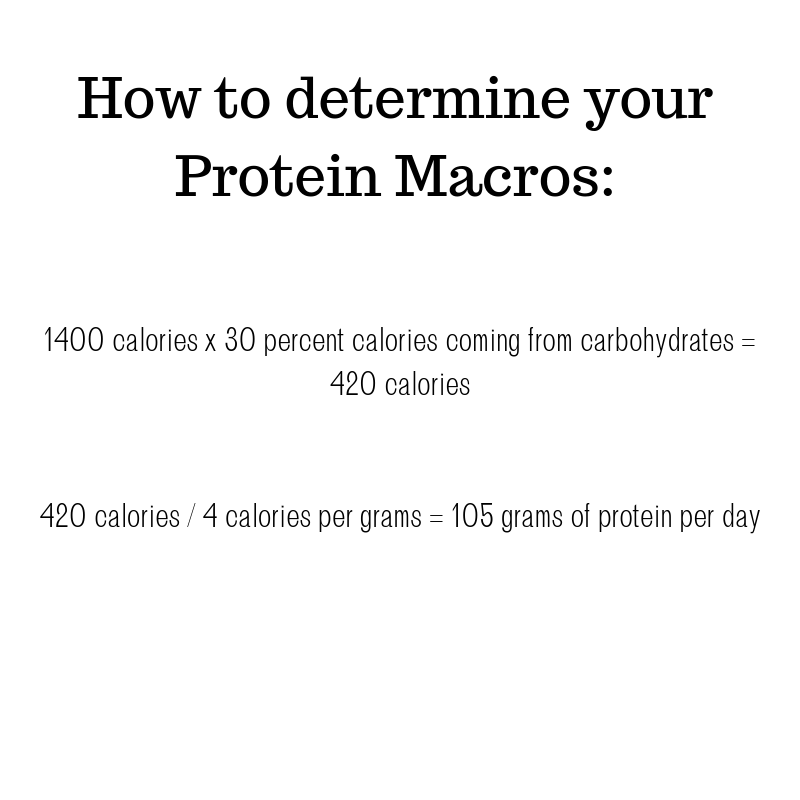 Fat and PCOS
Fat and PCOS
You might be wondering exactly where fat fits into a healthy lifestyle for PCOS. Despite its demonization, fat is an important part of our diet. Fat supports and cushions our internal organs, helps to regulate body temperature, and allows for proper absorption of several vitamins. Fat also provides the building blocks for many of our sex hormones. Fats are found in a variety of food from butter and oils to dairy products, meats and processed foods.
The right types of fats when carefully consumed can help improve insulin levels. Like protein, dietary fat alone doesn’t require insulin because it doesn’t breakdown into glucose. It also helps keep us satisfied longer thereby reducing overeating. Fat also has the unique ability to provide an increased palatability and mouth feel carbohydrates and fat don’t.
However, in spite of its many awesome insulin-lowering qualities you can’t eat as much fat as want. In fact, diets high in certain types of fats can actually contribute to IR, heart disease, hypertension and certain types of cancers.
How to Determine your Fat Macros when you have PCOS
When you have PCOS, I generally recommend keeping fat at around 30 percent of your total calories. This would mean if you were following a 1,400 calorie diet, you would should be consuming 47 grams of fat per day.
How did I get to that number? Let’s take a look at my math.
 Conclusion
Conclusion
Everybody and their mother is counting macros these days and you can too! All you need to know is how many calories per day you need to consume to meet your dietary goals. Then you simply apply the percentages 40, 30 and 30 respectively for carbohydrates, protein and fat. Lastly, you divide these values by each nutrient’s calorie value to arrive at your macronutrient amount in grams. Therefore, using the example noted above for someone following a 1,400 calorie diet their macros would be as follows:

Diet is critical in effectively managing PCOS. The foods we consume have a significant impact on our hormones. Balancing your hormones is critical to having an optimal metabolism. Since it is obvious that the underlying cause of PCOS is hormonal imbalance, it is not surprising that diet can impact the symptoms and metabolic consequences of PCOS. Determining your macros when you have PCOS isn’t difficult it just takes a little math! Macro patterns like the ones discussed in this article that support lower insulin levels should be an integral part of healthy diet for PCOS.
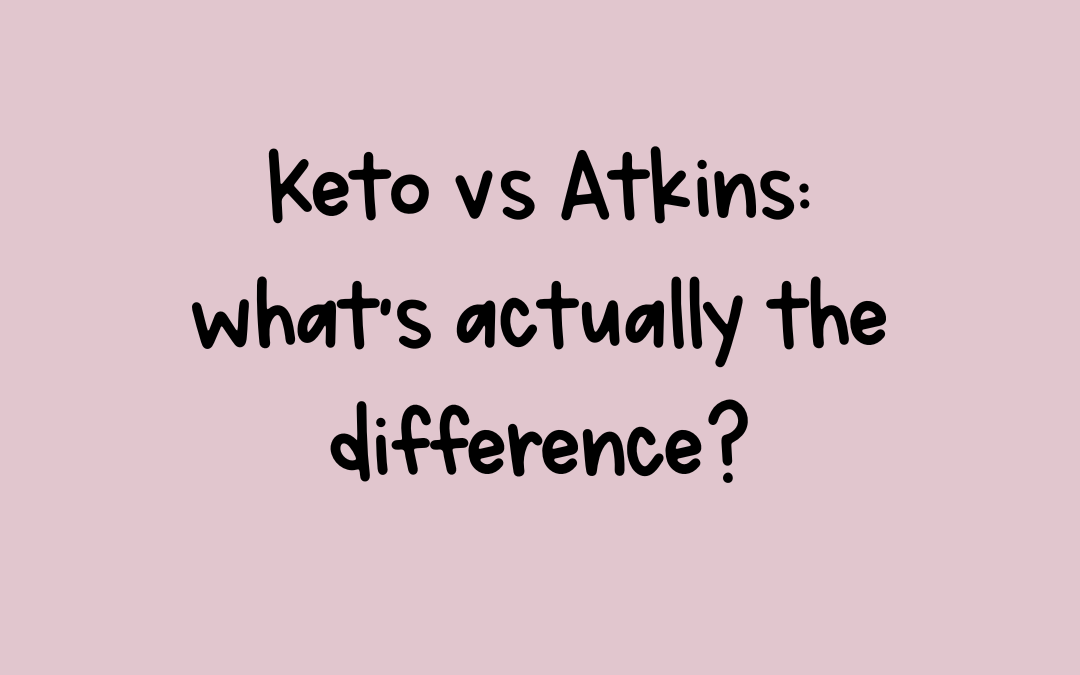
by AmyPlano | Jul 16, 2019 | General information about PCOS, PCOS and carbohydrates
Keto vs Atkins: what’s actually the difference?
Keto is such a hot topic these days but is it the same thing as Atkins? Both are low carb, high in fat and share a large majority of the same principles but there are differences. We are going to get to the bottom of this mystery once and for all.
The Great Debate: Carbohydrates Versus Fat
Few things in the world of nutrition are debated as much as “carbohydrates vs fat.” For decades we’ve been told fat is detrimental to our health. Meanwhile low-fat “diet” products, often full of sugar (and crap!) flood just about every aisle in the supermarket. Meanwhile, our population is fatter, sicker and on more medications than ever.

To eat carbs or not to eat carbs. That is the age-old question.
Therefore, it is no surprise that over the last few decades, low carbohydrate diets have made a resurgence. Also thankfully the pendulum has finally swung in a promising direction as it relates to fat intake. Many health professionals now support that a low carb diet is a viable option to treat obesity and other chronic, Western diseases.
Yay finally for legit science!
However, despite advances in research, there still seems to be confusion among the various low carb diets. In fact, one of the common statements I hear in my practice from patients is that they are following a ketogenic diet. But are they really?
More often that not – upon a quick review of their actual eating patterns it becomes apparent their eating style is more consistent with an Atkins diet rather than of a strict ketogenic diet. But does it really matter? Aren’t all low carb diets created equal and illicit the same results? The answer as you will see is not that simple.
Where do I Come in With All of This ?
It is important to note the goal of this blog is purely informational. As a practitioner I have no personal bias as it relates to a low carbohydrate diet. I am neither for or against them. I meet my patients in their health journey ‘where they are’.
With that being said, it is important that my patients are properly educated and not misinformed. Therefore, the intention of this blog is not to debate whether or not a low carb diet is healthy. The intention is to instead to address the differences and similarities of two of the most popular low carbohydrate diets: The Atkins Diet and the Ketogenic diet (aka just Keto). Both are low carb and share a large majority of principles and beneficial outcomes, but a few subtle differences exist too. But what are the main difference between these two diets? And do these differences really matter? Does one promote more long term health benefits? Let’s get some answers.
Similarities Between Atkins & Keto
Before we examine what makes both diets unique it is critical to address the similarities between Keto and Atkins. I believe it these striking similarities that often have someone thinking they are following one type of low carb diet; when in fact they are following a different approach.
Both are Low Carb Diets
At the most basic levels, both Atkins and Keto are low carb diets. However, surprisingly there is no standard definition of what actually constitutes the term “low carb”. Both Keto and Atkins respectively present and adhere to their own definitions. As you will see, it is these very definitions that set Keto and Atkins apart from one another.
Both are Built on the Premise of Ketosis
Definitions aside, it is fair to make the general assumption that a low carb diet restricts carbohydrates, such as those found in sugary foods, pasta, fruit and bread. For both diets, their success centers around lowering the body’s carbohydrate intake in an effort to lower insulin and consequently burn fat as fuel. This process is known as ketosis.
In the absence of carbohydrates the body produces ketones. Ketones are an alternative fuel source for the body to use when blood sugar (glucose) is in short supply. The goal of both Keto and Atkins is to tap into the body’s fat burning potential. Once this switch is flipped, the body changes from burning carbohydrates to fat.

Therefore, by restricting carbohydrates, insulin levels decrease, and fat burning increases dramatically. As we will see in this blog, ketosis plays a pivotal role in each of the diets but in different ways, thus affecting how sustainable each diet is in the long run.
Both Diets Place an Emphasis on Dietary Fat
High fats foods such a meat, eggs, full fat dairy and liberal amounts of fats form the backbone of both Atkins and Keto. However, Keto greatly favors calories come from fat. While on Atkins, fat receives less of an emphasis, with a more dramatic shift towards higher protein lower carb consumption.
Both Diets Provide Similar Health Benefits
Weight loss is the primary end goal of Atkins. While Keto was developed in the 1920’s as a treatment option for epilepsy. But recent research suggests the Keto and Atkins diets may provide health benefits including by not limited to weight loss, optimized blood sugar, improved insulin sensitivity, even reduced risks of various cancers and some neurodegenerative diseases (1, 2).
The Keto Diet
Keto by definition is a high fat, moderate protein, very low carbohydrate diet. The dietary approach is linear from start to “finish”. There is no maintenance plan once you reach your goal. Instead, you sustain the same fixed eating patterns indefinitely.
The Specifics of a Ketogenic Diet
♥ 5 – 10% of energy from carbs
♥ 20 – 30% of energy from proteins
♥ 65 – 80% of energy from fats
The primary goal of eating in tune with these specific percentages is to get the body in ketosis. By following this high fat, moderate protein, low carb diet the individual is able to significantly lower their insulin levels. This radical shift in fuels prompts the body from burning from glucose to creating and using ketones. In turn, facilitating fat burning.

Keto is a high fat, moderate protein,low carb diet.
Let’s be clear about something. Keto is a high fat diet. Not a high protein diet. So you don’t need/want huge amounts of protein. Protein in excess of what your body uses/needs can be converted to glucose, making it more challenging to get in (and stay!) in ketosis. Most people who think they are following Keto often fail to recognize this piece. They get confused with Atkins where protein intake is unregulated and encouraged. They think the same applies for Keto. Well, it does not. On Keto, protein intake needs to be determined and adhered to in order to maximize results.
Long Term Compliance on Keto
When following a true Keto diet, long term compliance with these specific guidelines is critical. If the guidelines are violated, the benefits of ketosis will not be actualized and the individual may actually end up gaining weight.
Therefore, in embarking on Keto the individual must make (and sustain!) significant, permanent, lifestyle changes. No compromising. No backing away. Just a full lifestyle adjustment regarding how you view food and nutrition. No biggie, right ?
Why You Need to Know your Baseline Calorie Needs on Keto
I know counting calories is often noted as not necessary on Keto. However, I am going to disagree here. Think about it. Keto relies on very specific percentages based on total calories consumed. While I agree due metabolic adaptations in relation to hormone regulation you can likely consume a higher level of calories – you still need a starting point for calories. If you do not establish a baseline level of calories, it is impossible to determine the actual percentages of fat, protein and carbohydrates you need to consume. Therefore, you need a starting point for calories to base your percentages off of. Makes sense, right?
The Atkins Diet
Now let’s transition to the Atkins diet and what makes it is this approach unique.
The Specifics of the Atkins Diet
The are four phases in the Atkins diet: Induction, Balancing, Fine-Tuning and Maintenance. The first phase is the most restrictive and vaguely resembles the overall platforms of a ketogenic diet with one major caveat; there is no restriction on protein just carbohydrates. As time progresses and the individual gets closer to their goal weight complex carbohydrate intake increases and the diet becomes less carbohydrate restrictive.
The 4 Phases of Atkins
Induction: Carbohydrates are restricted to no more than 20 grams per day. Emphasis is placed on high fat and high protein foods, with the source of carbohydrates coming from dark, leafy greens.
Balancing: Nuts are incorporated, low carbohydrate vegetables and small amounts of fruit.
Fine-tuning: As someone approaches their goal weight, they begin to add more carbohydrates slowing down weight loss.
Maintenance: High fiber carbohydrates are significantly increased and based on an individual’s level of “tolerance” more or less or added.
The Basics of Atkins
Fat: No defined amount although liberal consumption of high fat foods are encouraged
Protein: Also no defined amount although liberal consumption of high protein foods are encouraged
Carbohydrates: < 20 net grams of carbohydrates per day during Induction phase with increasing amount through the 4 phases
There are no restrictions on fat consumption. More importantly, there is no restriction on protein. You are encouraged to eat as much protein and fat as long as you keep your carbohydrates where they need to be in each respective phase. You don’t need to ‘hit’ specific percentages for your macronutrients. Additionally, you can eat as many calories as you like. Therefore, depending upon your personal eating style this can become a high calorie, high fat, high protein, low carbohydrate diet.
How Keto and Atkins are Different
So we have addressed both the similarities and the respective differences of Keto and Atkins. Now let’s talk about how they compare. Here is a summary of the keys points.

Differing Factor
|
Atkins
|
Keto
|
Carbohydrate Levels
|
Changes from phase to phase, starting with drastic reductions followed by gradual reintroduction.
|
Relatively Fixed level: Approximately 5-10% of total calories.
|
Carbohydrate Monitoring Method
|
Net carbohydrates
|
Total carbohydrates
|
Protein Intake
|
No limit
|
Often based pm approximately 1-1.5 grams of protein for each kg of bodyweight.
|
Fat Intake
|
No set amount – high fat foods encouraged
|
High fat intake. As much as 65 – 85% total calories.
|
Progression
|
4 phase process where carbs are slashed then gradually reintroduced.
|
Once nutritional ketosis is achieved optimal carb, fat and protein levels remain unchanged.
|
Ketone Production
|
Ketosis highest during phase 1. After that ketosis is decreased as carbs are slowly reintroduced.
|
Optimal production levels maintained throughout course of diet.
|
Time When Individual Achieves Ketosis
|
With ketosis the Atkins diet looks to achieve it in phase 1.
|
Depends on the individual.
|
Distribution of Macronutrients
Perhaps the most significant difference between Keto and Atkins is how the macronutrients are specifically distributed. Macronutrients (aka ‘Macros’) are the amount of carbohydrates, fat and protein someone should consume based on their specific needs. Keto as you have seen is highly specific with finite macronutrient ratios. While Atkins promotes a level of food quality (high fat, high protein, low carb) but makes no mention of actual quantity.
Carbohydrates
There is no denying the fact both diets are low in carbohydrates. However, long term Keto promotes a consistent lower carbohydrate diet. Generally speaking, most people on Keto keep their carbs below 30 – 50 grams for.ever. Yes, as already noted, there are no phases or progression of carbohydrates for Keto. Just one steadfast, unwavering level of uniform carbohydrate intake.
In the Induction phase, carbs on Atkins are set at 20 grams or under. However, as the individual progresses through the various phases additional carbohydrates are added. While these additional carbohydrates are not ‘junk’ carbs – the body still recognizes them with a similar blood sugar response. Additional carbohydrates promote an increase in blood sugar. This rise in blood sugar drives up insulin. Ultimately, knocking the individual out of ketosis.
Which raises the question: “Is Atkins a ketogenic diet?” The answer would be: “No.”
Atkins unfortunately diet does not turn you into a fat burner for the long haul. This is simply because as you progress you are allowed to eat an upward of 100 grams of carbs per day. This amount (for many) is sufficient for your body to keep burning sugar for fuel – not fat. Keto, on the other hand, requires sticking to 30 – 50 grams of carbs per day increasing the likelihood of long term ketosis.
Are All Carbs Created Equal?
One area of carb counting that can get a little confusing is the whole “net” carbohydrate situation. Atkins utilizes a net approach to counting carbohydrates. While Keto counts total carbohydrates. Don’t worry, though — it’s not nearly as confusing as it sounds.
Net carbohydrates are what you’re left with after subtracting the grams of fiber per serving from the total carbohydrate amount per serving. In this approach, you can also subtract sugar alcohols as well such as xylitol, sorbitol and erythritol.
For example, if an item has 30 grams of carbohydrates and it contains 10 grams of fiber, then the amount of net carbs the item contains is 20 grams.
According the creators of Atkins, the method to the madness is the net carb amount reflects the grams of carbohydrate that significantly impact blood sugar level. This follows the assumption there is little to no impact of both fiber and sugar alcohols on blood sugar. Therefore, when following Atkins these are are the only carbs you need to count. Foods that are low in net carbs such as nutrient-dense vegetables and low glycemic fruits such as berries don’t cause a significant impact on blood sugar and therefore are less likely to interfere with weight loss.
Matter of perspective
When it comes to counting carbs on Keto it really depends who you ask! Some true devotees of Keto will count total carbohydrates independent of fiber. While others followers of Keto aim for 20-25 grams of net carbs OR ~ 50 grams of total carbs. Either way you slice it the goal is to keep carbohydrates low enough to decrease insulin levels and facilitate fat burning.
Fat
The Dietary Guidelines set forth by the U.S. government promote a diet containing 20-35 % of total calories coming from fat. Therefore, comparatively Keto is considered a very high fat diet with 65 – 85 % total calories coming from fat. Atkins is also higher in fat than your typical recommended diet. But not as high as Keto. The emphasis is slightly different with Atkins. The focus to is instead on removing carbs while equally boosting protein and fats.
Also unlike Keto, there is no set amount of daily fat you are required to consume on Atkins. The main emphasis on Atkins is to keep carbohydrates below the set level for each phase. While high fat foods are encouraged, fat intake can vary from person to person.
Protein
On Keto an ‘adequate’ or ‘moderate’ amount of protein is encouraged. While on Atkins protein intake (like fat intake) has no set amount. Therefore, it is possible for Atkins to become a low carbohydrate, high protein, high fat diet. Why does this matter?
Certain factors like eating too much protein can (for some individuals) get in the way of ketosis and increase the need for gluconeogenesis. Gluconeogenesis is just a fancy term for making glucose from non-glucose sources like protein and fat. It’s a process when your body converts excess protein or dietary fat you eat into blood sugar for energy. Some researchers believe the protein sources commonly consumed on a low carb diet have the propensity to raise insulin levels. In response to an increase in insulin levels, ketogenesis is down regulated.
This is why eating ‘too’ much protein can impair some individual’s ability to get in and stay in ketosis. But, this does not mean you should restrict your protein consumption either! But what it does mean is someone following Keto NEEDs to determine their adequate level of protein intake. A good general rule of thumb is to aim for 1.0 – 1.5 grams of protein per kg body (3). To convert your weight into kg simply multiply your weight in pounds by 0.45.

By taking the time to determine what a moderate level of protein intake looks like, the individual on Keto can both optimize their fat burning potential and prevent lean muscle breakdown. However, your protein needs are dependent on your activity level, weight, height, gender, body composition, stress and inflammation levels in your body, etc. So keep in mind this calculation is a very basic way to determine adequate protein intake. If you are a competitive athlete you will likely need to adjust this value.
Comparative Summary
In summary, it is fair to say when it comes to Keto and Atkins, Keto is much more specific with very finite guidelines. While Atkins can be seen as more ‘loosey-goosey.’ In order to achieve the benefits of Keto you have to be very precise. While the Atkins diet is more flexible. Hence Atkins could be seen as less intimidating prompting more people to try their hand at this approach. With that being said, some people thrive on a rule-based approach. They need profound structure because otherwise they’re going try to break/bend the rules at any occasion they see fit. So, it really comes down to the individual.
Which One is Better?
In all honesty, despite their similarities and differences I really don’t know which one is ‘better’ per say. My personal stance is “Different strokes, for different folks.” My goal is to meet my patients where they are and guide them based on the scientific evidence that exists. I personally think an argument could be made for pretty much any dietary approach out there. SO I guess it really lies in someone’s goals, level of dedication, persona and long term personal outlook on health and wellness.
Some people just can’t wrap their arms around a low carb, high fat diet. It is SO foreign to them. While others, embrace this dietary approach with unwavering optimism. I think the big thing with either diet is knowing the score. Based on my knowledge, the intention of Keto is more of a true lifestyle change. While Atkins seems for most to be a fairly short-term guide to weight loss. So if you are as they say, ”In it to win it,” I would recommend you go ‘all in’ with Keto and do it right.

But truth be told – I have never.ever.ever. met anyone to be consistent long-term with either approach. Inevitably for most — pizza happens 🙂 But maybe that is just the circle of patients, friends and family members I run with?
Well, I guess that is not true. Research supports long term compliance (> 12 months) on a very low carb diet in the general population is fairly low (4, 5). Surprised? I didn’t think so. Does that mean this approach is wrong? No. It just means a very low carbohydrate diet is very hard to sustain.
My Personal Experience is All I Have GOT!
Also I can only speak from my personal clinical experience. But once people go back to eating normal- carbs and all – they seem to gain weight back with interest. That is because each gram of carbohydrates pulls into 3-6 grams of water into the body. When you significantly decrease your intake of the carbohydrates – you simply take on less water. Increasing protein intake can also have a diuretic effect on the body. Therefore, it is not a surprising when a person goes off a low carb diet – they often experience shifts in fluids and therefore fluctuations in weight.
So I guess the next question becomes can we get the benefits of a ketogenic diet without being going gangbusters with Keto or Atkins? The answer is YES. If there is any uniform message here the key to success is managing insulin. And ‘Hello!” there are numerous ways to that! Last we I talked your ear off about Intermittent Fasting. But you don’t have to go Keto or even engage in Intermittent Fasting if that is not your bag. In fact, the number one insulin sensitizer is exercise!!! Plus, exercise has a host of other extremely beneficial side effects beyond just lowering and managing insulin. So why not start with the lowest hanging fruit? No need to complicate matters anymore than they already are 🙂
One more thing
And one more thing. What gets measured gets managed. Really want to knock it out of the ball park? Start tracking every morsel that goes in your mouth. And I do mean everything! Because before you even begin thinking about changing your dietary approach you need to understand the current status of your diet. The only way to do that is track what you eat and review the data. Plain and simple.
Need help getting started? Why not enlist the help of one of fabulous Plano Program’s Registered Dietitians? They can not only help you determine the most effective food tracking platform – but they can provide an overall assessment of both the quality and quantity (Hello macros!) of your diet. The best part? They are likely covered by your health insurance. So why not take advantage of the awesome opportunity to have someone help you determine what to eat? Make an appointment now by clicking here.
Phew. That was a mouthful! I hope you found the information helpful. If anything I hope it empowers you to select the most appropriate dietary approach when it comes to low carbohydrate diets.
Hugs & High Fives,
Amy
P.S. What have been your personal experiences with low carb diets? Do you find one type of low carb diet was easier to sustain than the other? After reading this were you following one type of low carb diet – when you really were following another type? Please share your experience in the comments below.
References
- Halton TL, Willett WC, Liu S, et al. “Low-carbohydrate-diet score and the risk of coronary heart disease in women.” N Engl J Med. 2006;355:1991-2002.
- Halton TL, Liu S, Manson JE, Hu FB. “Low-carbohydrate-diet score and risk of type 2 diabetes in women. “ Am J Clin Nutr. 2008;87:339-46.
- American College of Sports Medicine position stand. “Nutrition and athletic performance. American Dietetic Association., Dietitians of Canada.,” American College of Sports Medicine., Rodriguez NR, Di Marco NM, Langley S.Med Sci Sports Exerc. 2009 Mar; 41(3):709-31.
- Hu T., Yao L., Reynolds K., Niu T., Li S., Whelton P. K., He J., Steffen L. M., and Bazzano L. A. (2016) Adherence to low‐carbohydrate and low‐fat diets in relation to weight loss and cardiovascular risk factors. Obesity Science & Practice, 2: 24–31.
- Grant D Brinkworth, Manny Noakes, Jonathan D Buckley, Jennifer B Keogh, Peter M Clifton; Long-term effects of a very-low-carbohydrate weight loss diet compared with an isocaloric low-fat diet after 12 mo, The American Journal of Clinical Nutrition, Volume 90, Issue 1, 1 July 2009, 23–32.

by AmyPlano | Jul 9, 2019 | PCOS and carbohydrates, Uncategorized
J.E.R.F.
Today’s nutrition tip is brought to you by the acronym J.E.R.F. – Just Eat Real Food. There are a million ways to spin off of this word (and the relative term real) but the direction I am going to is with ‘pseudo’ foods. Bare with me … I promise you don’t need to eat cauliflower to feel the love.
Last week I posted this silly quote on social media:

And while it definitely made my chuckle – it also made me realize just how many foods we come across on a day-day basis are foods that have turned into things they really are not:
-
- Cauliflower pizza
- Cauliflower tots
- Cauliflower rice
- Mashed cauliflower
- Noodles made from zucchini, carrots, butternut squash
- Coconut ice cream
- Riced broccoli
- Impossible burgers– non-meat burgers that ‘bleed’ beet juice
- You get my point here 🙂
Cauliflower pizza IS NOT pizza.
And truth be told most versions don’t even remotely come close to the real deal pizza. In all honesty, most cauliflower pizza is not EVEN that much healthier. The crust is generally made with cheese, eggs and more cheese. I have nothing against cheese or eggs– but when you spec it out most can clock in just as high in calories as regular pizza depending on the toppings.
I love zoodles every. once. in and a while.
Of course they are a vegetable high in fiber, nutrients and vitamins and minerals. But what is wrong with having real pasta every once and a while? Yes – I know the carbs. But say you really love pasta why not just have the real deal occasionally in small amounts?
Riced broccoli — first of all have you tried it? It tastes just like broccoli! But are you surprised. Likely not because it IS broccoli.
Anything vegan trying to resemble meat – my only question is a big fat WHY?
Why not just eat real meat if that is the flavor, texture profile you are going for. I can only get away with saying that because I was a vegetarian for 10 years, a vegan for 2 years and a raw vegan for 1 year. I also used to have long dread locks and lived in Costa Rica – so go figure! Now I eat meat – love it – and often I am embarrassed to tell you that I used to eat something called “tuno.” No that is not an expensive Italian tuna in a high grade olive oil. Tuno was a ‘fake’ vegetarian based “tuna” that came in a can and smelled like tuna. Wicked gross.
Bottom Line
My point here is don’t eat foods because you feel like you have to. If you love riced broccoli then … rock on with your bad self! But don’t feel like you have to love it and convince yourself it tastes like rice. Because it certainly doesn’t! Also remember – you don’t have to be anyone or anything you don’t want to be. So why should your food be any different?
You don’t have to eat cauliflower pizza and ‘pretend’ it is delicious. Why not just head down to Modern Pizza once a month and tear it up? (When you do might I suggest the Veggie Bomb with hot cherry peppers!)
Furthermore, you don’t have to kill yourself and do a Whole-30 and deprive yourself of dairy when you love cheese. What are you going to do after you the 30 days? Will you never. ever. ever. return to eating your favorite food group? Survey says – I think not my friend! So why torture yourself and take something out of your diet you love. We have to be realistic with our food choices. If not then behavior change becomes unsustainable and we crash and burn every single time.
You see pizza, tater tots, rice and pasta are NOT the enemy. It is the way we abuse these foods and our relationship with them that makes them unhealthy.
Love yourself enough to eat the real deal
Do you think eating pizza or cheese for that matter will completely derail all your hard work? Hardly. Eating them every day – highly likely! But occasionally eating the foods you love — you know the ones that puts a smile on your face — should be part of your lifestyle These foods are not something you should try to replace. Because you and I both know there is absolutely no replacement for great REAL high quality food.
See part of the cool thing about the food we put into our bodies is that for many of us it is one the few things in life we can control. So why not make a pack to yourself that you are no longer going to eat something just because you feel like you should. You are no longer going to feel bad because you just don’t love spaghetti squash. Instead you are going to have a small serving of the real deal with some awesome sauce and homemade meatballs and call a night. You are not going to feel bad. You are not going to feel like you failed. Instead, you are going to be proud that you made a conscious decision to eat real food that made your little heart sing.
I wanted to leave you with some parting words ♥


by AmyPlano | Jun 23, 2019 | PCOS and carbohydrates, PCOS and Weight Gain
Did you know there are over 50 DIFFERENT names for added sugar ? Now, that is KRAZY with a capital K!
And let’s be crystal clear – I am NOT talking about the type that naturally occurs in fruits, veggies, whole-grain products as well as in dairy. We are talking about the sugar that is added to food during processing to enhance flavor, texture and shelf life.
Added sugar is typically composed of the either glucose, fructose and/or sucrose. Unfortunately, many food manufacturers are sneaky and hide the total amount by listing it under several different names on a package’s ingredient list.
As if reading labels wasn’t hard enough to begin with!
Any look familiar?
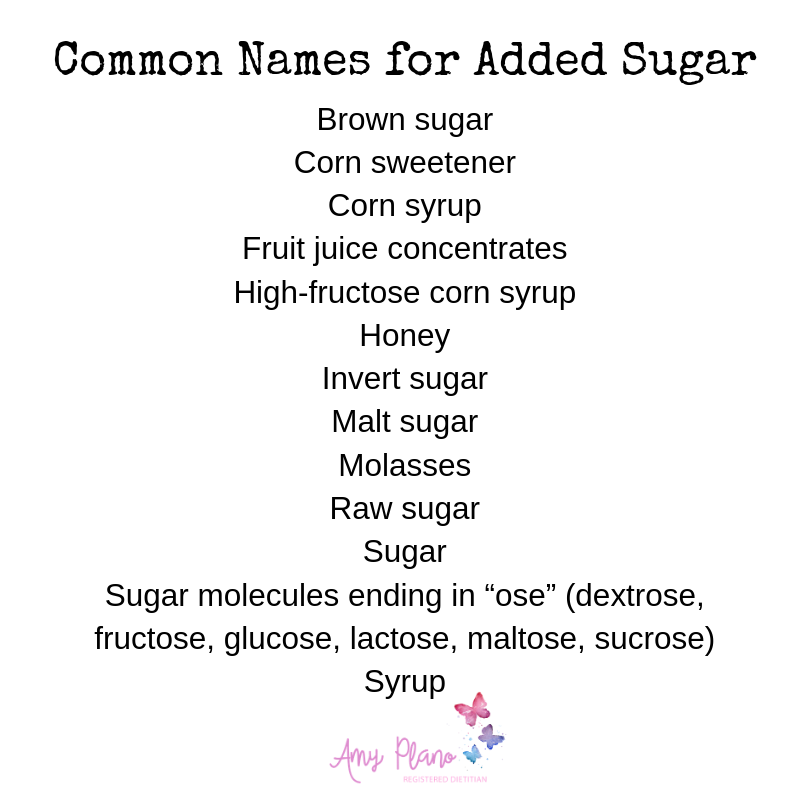
However, sadly the list does not end here my friends. Check out this quick article from Healthline to learn about the 56 (yes, you read that correctly!) other names that sugar goes by.
Talk about an unsavory alias!
Do any of these surprise you?
Raise your hand if you thought agave was a better choice than white sugar?
Surprised to hear that coconut sugar is a “no-go”?
That leads us to the next important question.
How much added sugar are you allowed per day?
Survey says…
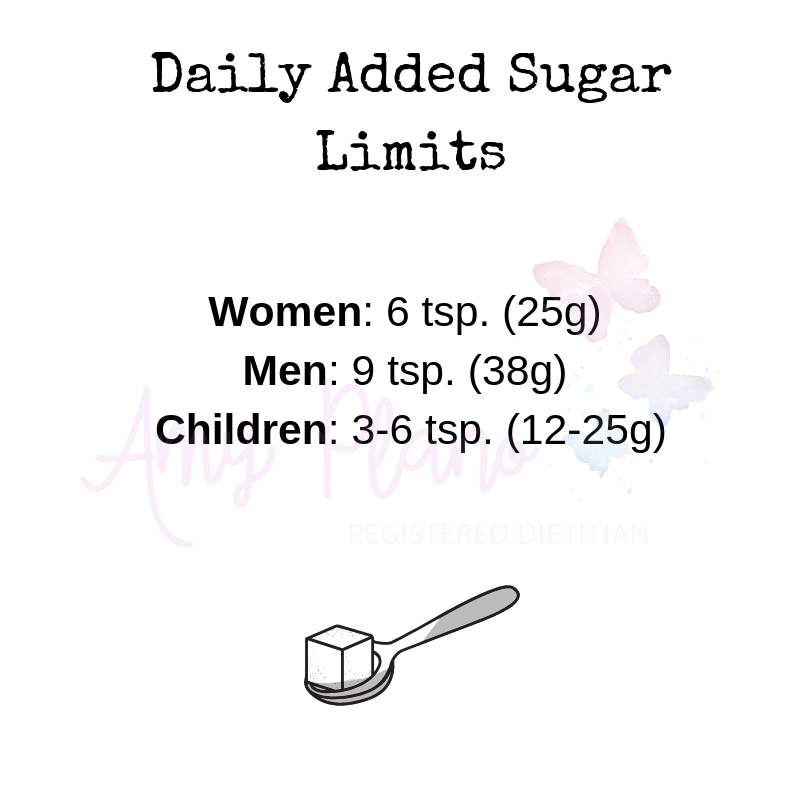
But let’s not sweat the small things. Whole foods like fruits, veggies, whole-grains and dairy products naturally contain small amounts of sugar. However, they are also nutrient powerhouses brimming with fiber, vitamins, minerals and phytonutrients. With these added features, whole foods are processed differently and don’t have the same detrimental effects of added sugars.
Therefore, the most effective way to reduce your added sugar intake is to J.E.R.F. – just eat real food. Plain and simple.
However, if you do decide to buy packaged foods, don’t be a slave to label. Be an informed consumer and stick to your daily quota.
Got questions on added sugars? Hit us up in the comments below. We understand this topic can in fact be tricky and we are happy to help!
Hugs & High Fives,


by AmyPlano | Jul 17, 2017 | PCOS and carbohydrates, PCOS and Fats, PCOS Breakfast Foods
PCOS Friendly Bread – Yes It Does Exist
I know what you are thinking – the word PCOS and bread should not even be in the same sentence. But guess what? That is where you are wrong ‘cysta! I have been dying to share with one of my favorite PCOS friendly breads – Dave’s Killer Bread. Yup – I agree with you! Super, duper, cheesy name. But all situations aside I will let this goober get away with it as it just that good.
I feel like I must have read a review about the bread a while back. Shopping at Shop Rite in Milford, CT a couple of weeks ago – the bread seemed to jump out at me. The label is memorable for sure! Most breads don’t have a long-haired dude strumming a guitar on the front of the package. SO I guess I am not super surprised I was drawn to it. Are you? Of course – being the foodie that I am — I needed to try it. So, of course I bought all three different types that Shop Rite had.

Front of the label for Dave’s Killer Bread – go get yo’self some.
Dave’s Killer Bread Claim to Fame
Independent of its taste – which I will get to in a second — Dave’s Killer Bread has several great characteristics that make it one the few PCOS friendly breads I trust. Number one, the ingredients are all high quality. They only use USDA organic ingredients. They also claim all their ingredients are made from non-genetically modified seeds. It is important to note that the label claim “Non-GMO”claim is not yet supported by FDA. However, usually a third-party does come in verify the validity of this claim. So, you have to give Dave props for going through all that effort to do this.
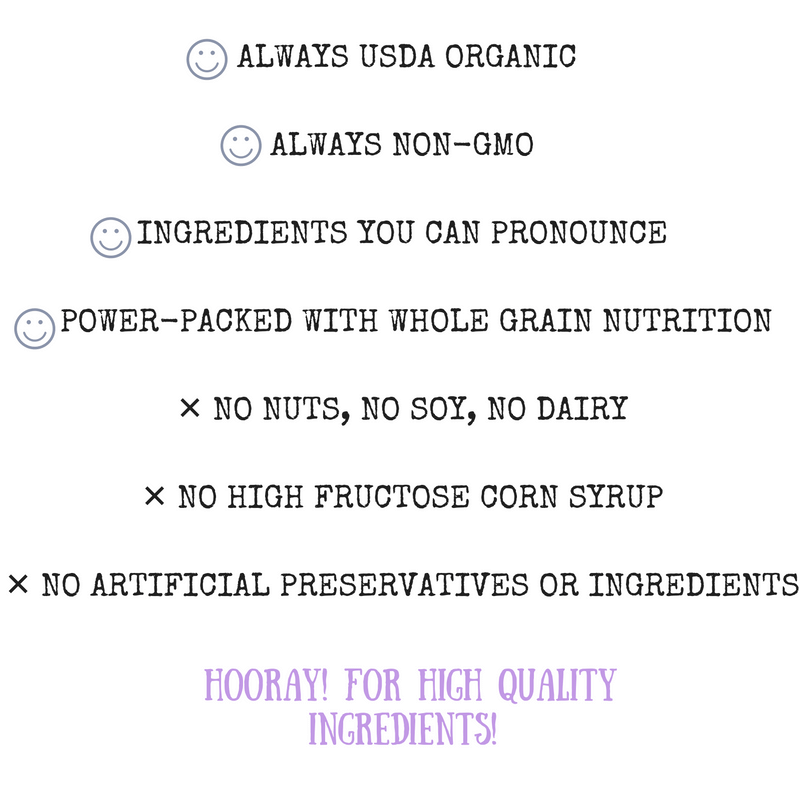
Only Ingredients You Can Pronounce
Next, I promise, you can pronounce all the ingredients. In addition to being able to pronounce them – you easily can find what they are. I reviewed all the varieties of Dave’s Killer Bread and there was not one single ingredient I had to question. Below you can see the ingredients I took directly off a loaf of Dave’s Killer Bread – 21 Whole Grains & Seeds. Remember when purchasing bread you always want the word “whole” to appear within the first 3 ingredients. This signifies the ingredients are in fact made from whole grains and not processed. As you can see – this bread fits that criteria.
The Macronutrient Breakdown is Solid
PCOS friendly breads are hard to come by – but Dave’s Killer Bread makes it both easy and tasty to accomplish this task. Dave’s Killer Breads sells several different variety. But one of the things I like is there is an entire line of thin-sliced breads that deliver the same killer taste and texture in a smaller, lighter package. One slice of the regular bread has about 120 calories, 22 grams of carbohydrates, 2 grams of fat and 5 grams of protein. While the thin-sliced variety only have 60-70 calories (depending on which one you choose), 12 grams of carbohydrates, 1 gram of fat and 3 grams of protein.
I know what you maybe thinking – how thin is thin? Not too thin – I promise. I often cringe when people tell me they eat “diet bread” (the first thing that comes to mind is Sara Lee – yuck!) that is paper-thin. Why even bother? Put that crap in the toaster for too long – and you have a three-alarm fire. That is not at all what I am talking about.
In all seriousness, I did not even consciously buy the thin-sliced bread. I just bought what they had which happened to be the thin-sliced variety. I did not even noticed it was thin-sliced until it was all gone and I needed to go to the store to buy more! It was only then that I noticed that Dave even made what they would consider a traditional, thicker slice. I bought that too and it was as good – but not drastically different from the thin-sliced variety. So there is no need to “upgrade” to the big girl slice — unless you want the extra calories and carbohydrates.
Did someone say fiber?
You know how much I love talking about the benefits of fiber for women with PCOS. If fact, I think my patients want to kill me sometimes when I hammer them about meeting their daily fiber targets. Which for most folks is a whopping 28 – 35 grams of fiber per day. The average women only consumes about 15 grams – 50 % less than what is required. And we wonder why we are hungry all the time!?! Not only does fiber help keep us full, it also helps control blood sugar by promoting the liver to release blood sugar more slowly. Given that women with PCOS are more likely than not to have issues with their regulation of blood sugar and insulin there is no reason they should not be meeting their fiber goals.
Dave’s Killer Bread helps us get one step further to meeting our fiber needs. Each slice of Dave’s Killer Thin-Sliced Bread has 3 grams. So if you make yourself a pretty little sandwich you have yourself 6 grams of fiber. While, that may not seem like a lot – once you start adding all sorts of good-looking veggies to your sandwich you are well on your way to meeting your daily fiber totals. Round out the meal with some guacamole or humus with raw veggies and well what can I say – you’ve got yourself a nice high fiber meal.
Baby Got Omega-3s
Does the word Omega-3s ring a bell? Remember a couple of weeks ago when we were chatting about all the amazing benefits of fats for women with PCOS? Well, if you missed it – or maybe just forgot click here to read more about PCOS friendly fats. Omega-3 Fatty Acids are a specific type of polyunsaturated fat that is essential to our body. This means our body cannot produce them – so we need to get them from the food we eat. Omega 3’s are most known for their role in reducing inflammation.Plus studies support that the right levels of Omega 3’s can reduce cholesterol, triglycerides and blood pressure, lowering your chance for heart attack, stroke or other cardiac event.
Dave’s Killer Bread is one of the few breads on the market to actually contain Omega 3’s that I know of. I imagine other exists – they have just yet to cross this girl’s path! Each slice of the thin-sliced variety has 130 mg per slice. While there is no finite recommendation for Omega 3 intake, it is fair to say that more is almost always better. While we would love to see people eating fatty fish that has Omega 3’s, I think it is fair to say this is not happening. So if someone can squeak in some Omega 3’s in – especially in an assuming source such as bread – I am all for it. Top your bread off with some grass-fed butter (Kerry Gold is my absolute favorite!) or organic nut butter and you just jacked up your Omega 3’s without batting an eye. Boom!
Dave’s Killer Bread Has a Killer Mission
I admit it – I am a sucker for a anyone or company who gives back. I don’t care what you are giving back – whether it be shoes, money, time, hugs or just smiles I think it is just great when people try to make some else’s life better. Companies like Toms Shoes, The Company Store and Good Spread have a place in my heart. Not to mention amazing people like Theresa on Pit Bulls and Paroles who rescues and finds homes for thousands of pit bulls each year. It is amazing how selfless companies and regular people alike can actually be. Especially in this day in age when everyone seems to be drinking their own flavor of hater-ade.
Well, the Dave’s Killer Bread company has an equally heart warming story. The company states that one in three of their employee partners has a criminal background.
“At Dave’s Killer Bread, we believe everyone is capable of greatness and that a second chance can lead to positive lasting change. In 2015 we introduced our non-profit, the Dave’s Killer Bread Foundation, with the mission to inspire other businesses to become Second Chance Employers and affect positive societal change. “
They even have a foundation for reducing the negative impact of mass incarceration and recidivism in America. Their foundation provides programs for businesses looking to adopt or improve these practices. I am mean honestly how cool is that?
Now the moment you have all been waiting for – how does Dave’s Killer Bread taste? I think it tastes pretty awesome! If I were to use one word to describe the bread it would be ‘hearty’ yet not overly heavy and dense. Despite being a whole grain, Dave’s Killer Bread still retains a good deal of lightness. I found it soft with a very light sweetness. Obviously, depending on the variety you buy you may have more or less seeds. I found it was good on a sandwich and just as good on its own with butter or peanut butter. I even made French toast with it which came out quite awesome if I have to say so myself!
But just a quick word of caution – do check the expiration dates. The first couple of loaves we bought were killer literally. But the second batch seemed a little dryer – if not slightly stale. A quick little pop in the toaster remedied that. However, I might pull from the back of the shelve as most stores likely do first in – first out placing the older ones in the front.
So that’s a wrap for this week’s blog. Have you tried Dave’s Killer Bread? Or do you have a PCOS Friendly Bread you recommend? Please let our PCOS community know in the comments below. We would love to hear from you!


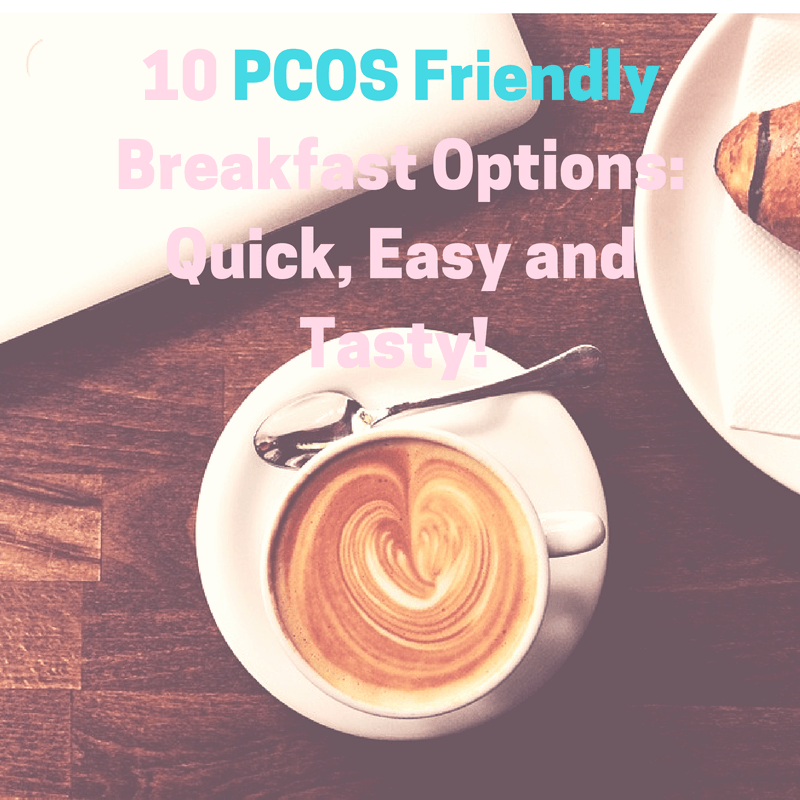
by AmyPlano | Nov 7, 2016 | PCOS and carbohydrates, PCOS Breakfast Foods, PCOS friendly recipes
PCOS Friendly Breakfast Choices
There is no denying it – breakfast is the most important meal of the day. Breakfast gives you energy and provides the body and brain with fuel after an overnight fast. Breakfast can help improve memory and concentration levels. It can also help with weight management as you are less likely to overeat eat later in the day after having a healthy breakfast. But this is easier said than done. Cooking up a PCOS friendly breakfast can be challenging – but it should not have to be. Especially because there are so many breakfast options that are super easy, tasty and healthy

For someone with PCOS, you should aim for a breakfast with 30 grams of carbohydrates or less. In addition, you should do your best to include a protein source to help keep you full longer. Good protein sources include: greek yogurt, organic eggs, cottage cheese, whey protein, nitrate free turkey sausage or low-fat cheese) You don’t want to start your day off super carb heavy – as it will usually set the sluggish tone for the whole day. Plus, jamming down a pile of carbohydrates in the morning is not good for your blood sugar and insulin levels. Most of all, this only sets the scene for your blood sugar to come crashing down. We want to avoid this scenario at at any cost.
Consequently, you are thinking – what the heck can I eat that is quick, easy, tasty AND PCOS friendly? Well the PCOS Dietitian is going to share some of her favorite breakfast choices that fit the bill.
10 Quick and Easy PCOS Friendly Breakfast Choices
1. Make a yogurt parfait with Greek yogurt and add a serving of fruit, nuts, and/or granola. Most of all when choosing yogurt purchase one with less than 15 grams of carbohydrates per serving.
2. Cottage cheese is a great source of protein. As with yogurt, you can add fruit, nuts or even chia seeds to create a more balanced meal. I personally love the Friendship brand. I recommend the 2 % or 4 % fat as they taste pretty awesome.

Friendship cottage cheese is my personal favorite! This is because it creamy and has a nice overall favor profile.
3. Make oatmeal (please, use old-fashion oats if you have the time!) and add a source of protein such as nuts, nut butters, protein powder, or milk. Thinking about other cereal choices but not sure where to turn? Check out this past blog on PCOS friendly cereal options. You can also have eggs on the side or scramble some directly into the oatmeal.
4. Have a protein shake. Blend together a small serving of fruit, milk or a milk alternative such as almond or cashew milk, and protein powder. Be creative with your combinations. because the sky is the limit with shakes.
5. Make a breakfast burrito on a low carbohydrate wrap with a couple whole (yes, eat the yolk – that is where all the good nutrition is!) cage free organic eggs, cheese, and tons of vegetables. You can even top of your master piece with a couple tablespoons of black beans, salsa and Greek yogurt to bump up the protein even further!
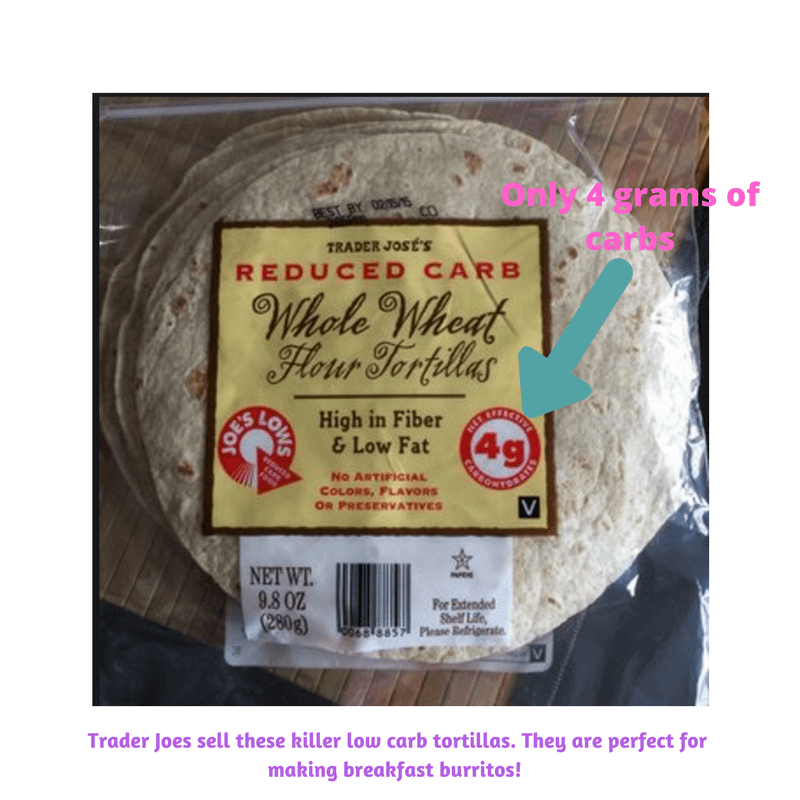
6. How about some tasty, high protein chia pudding packed with omega 3’s and tons of fiber? Check out this awesome chia pudding recipe here from last week’s blog!
7. Make a healthier eggs benedict on ½ whole wheat English muffin topped with vegetables such as steamed spinach and a poached egg. Rather than use regular bacon – swap it for Canadian bacon. You can get the same flavor without all the fat.
8. Omelets are a fun breakfast option. Be creative and add a variety of vegetables. You can also pair it with a side of fruit or toast – just not both!
9. Want something super quick and easy – try my recipe for Chocolate Chip Banana Greek Yogurt Muffins. What’s not to like?
10. Hard-boiled eggs are great for a quick breakfast. Pair them with a slice of whole-wheat toast with peanut butter or small grab and go fruit such as a small banana, small apple or pear. Trader Joes sells eggs that are already cooked – which makes not having a protein with your breakfast not an option for even the laziest of PCOSers!
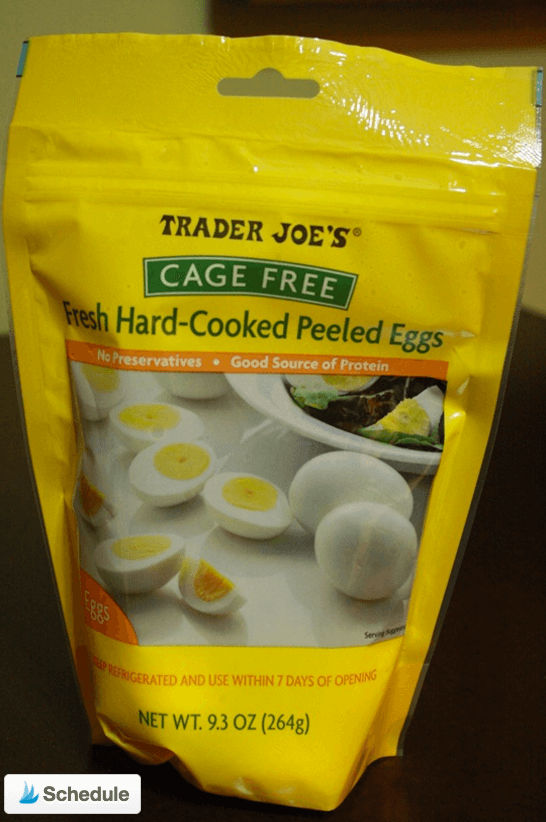
Already cooked hardboiled eggs – what could be easier?!?
Breakfast can be such a challenge but it does not have to be. Hopefully these PCOS friendly breakfast options provide you with some food for thought 🙂 As always, if you are looking for other great recipes please visit my Pinterest page and just search for Amy Plano, The PCOS Dietitian. I am a pinning maniac!
Got quick and easy breakfast choices you would love to share? I know you do! Please share your breakfast ideas in the comments below. As always thanks for stopping by.






 Fat and PCOS
Fat and PCOS Conclusion
Conclusion
